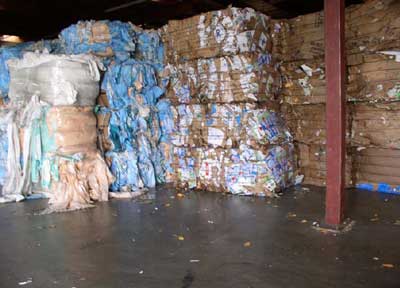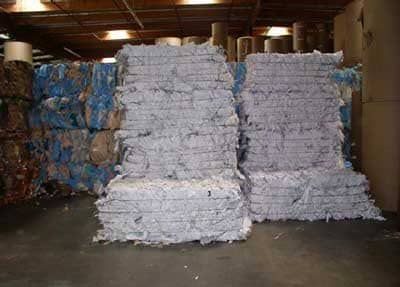A Hispanic Laborer Dies When a Stack of Paper Bales Collapses Onto Him.
| California Case Report: 07CA002 |
Summary
A 58-year-old Hispanic laborer died after being crushed by a stack of baled, recycled paper that collapsed onto him. The victim was sweeping the floor next to the stack of bales when the incident occurred. The paper bales were stacked six high and each one weighed approximately 1,000 pounds. The employer of the victim did not have a safety or training program for the employees. The employees who worked on the warehouse floor did not speak English. The CA/FACE investigator determined that, in order to prevent future occurrences, employers should:
- Ensure that the bales of recycled paper are stacked safely.
- Establish and maintain an Injury and Illness Prevention Program (IIPP) in the languages employees can comprehend.
- Establish and maintain training and testing programs that verify and document employees’ achievement of skills.
Introduction
On April 10, 2007, at approximately 5:00 p.m., a 58-year-old Hispanic laborer died when he was crushed by stacked bales of recycled paper that collapsed. The CA/FACE investigator learned of this incident on April 11, 2007, through a facsimile from the West Covina District Office of Cal/OSHA. The victim’s employer was contacted on April 26, 2007. On May 2, 2007, the CA/FACE investigator traveled to the company that employed the victim and interviewed the company’s owner and other employees in the warehouse. Photographs of the incident scene were taken.
The victim’s employer was a waste management company. The company stored, loaded, and shipped bales of recycled paper. The company had been in business for five years and had eight employees. There were six employees at the job site where the incident occurred. The victim had worked for the company for two months. The victim was born in El Salvador and had been in the United States for less than a year. The victim was a college graduate and spoke only Spanish. The company did not have a written Injury and Illness Prevention Program (IIPP). Safety meetings were not held on a regular basis. The company did not have a training program that provided safety training to employees.
Investigation
The site of the incident was a warehouse that made bales of recycled paper and stored them for transport by rail. The warehouse was filled with bales of different types of recycled paper stacked on top of one another. Each stack of bales was approximately 20 feet high. Each bale measured approximately six feet in length and three and one half feet in depth and height. The bales were held together with four wires tied across the length of the bale. Each bale was estimated to weigh approximately 1,000 pounds. The bales were made in the warehouse with a baling machine. After the bales were made, an employee using a forklift would lift the bale and stack it according the type of paper that was in the bale. The bales were stacked as high as six bales in some cases, depending on available floor space. There was no stacking plan so employees followed past practices of stacking as directed by management and had not had any prior incident to indicate unsafe stacking practices.
On the day of the incident, the victim was sweeping the floor of the warehouse near a stack of baled recycled paper. Without warning, the stacked bales of recycled paper collapsed on top of the victim. The bales crushed the victim. Another employee who was operating a forklift in the vicinity saw the bales collapse and ran for help. Other employees came to assist and helped remove the bales off the victim with the use of a forklift. The paramedics and fire department arrived within minutes and pronounced the victim dead at the scene.
Cause of Death
The cause of death, according to the death certificate, was crush injury to the torso.
Recommendations/Discussion
Recommendation #1: Ensure that the bales of recycled paper are stacked safely.
Discussion: Material, wherever stored, should not create a hazard. It should be limited in height and be piled, stacked, or racked in a manner designed to prevent it from tipping, falling, collapsing, rolling, or spreading. Racks, bins, planks, sleepers, bars, strips, blocks, and sheets can be used where necessary to make stored material stable. In this particular case, none of the above methods were used. The uneven bales of recycled paper were stacked six high on top of one another, creating a potential falling or collapsing hazard. The material that collapsed on the victim had been stacked in that position for more than two weeks, causing it to settle and become unstable. Had the employer used some external support for the stacked material, this incident might have been prevented.
Recommendation #2: Establish and maintain an Injury and Illness Prevention Program (IIPP) in language employees can comprehend.
Discussion: In this particular case, the employer had no safety program in place for the employees to follow. Having a documented safety program and an Injury and Illness Prevention Program (IIPP) has proven to be an effective method of ensuring all employees receive the necessary safety information needed to do their jobs. An effective IIPP should contain the following:
- The name of a person or persons with authority and responsibility for implementing the IIPP.
- A system for ensuring that employees comply with safe and health work practices.
- A system for communicating with employees in a form readily understandable by all affected employees on matters relating to occupational safety and health, including provisions designed to encourage employees to inform the employer of hazards at the worksite without fear of reprisal.
- Procedures for identifying and evaluating workplace hazards, including scheduled periodic inspections to identify unsafe conditions and work practices.
- Procedures to investigate occupational injury or occupational illness.
- Methods and/or procedures for correcting unsafe or unhealthy conditions, work practices, and work procedures in a timely manner based on the severity of the hazard.
- Training and instruction.
Employers having fewer than 10 employees can communicate to and instruct employees orally in general safe work practices with specific instructions with respect to hazards unique to the employees’ job assignments. Had the employer had a safety program in place, the hazard might have been identified and eliminated before this incident occurred.
Recommendation #3: Establish and maintain training and testing programs that verify and document employees’ achievement of skills.
Discussion: In this particular case, the employer had no training program in place for the employees to follow. The purpose behind a documented training and testing program is to ensure all employees receive the same safety information and that their achievement of skills is verified before proceeding with any given task. A training and testing program should be given:
- To all new employees;
- To all employees given new job assignments for which training has not previously been received;
- Whenever new substances, processes, procedures or equipment are introduced to the workplace and represent a new hazard;
- Whenever the employer is made aware of a new or previously unrecognized hazard; and
- For supervisors to familiarize themselves with the safety and health hazards to which employees under their immediate direction and control may be exposed.
Employers can enhance worker compliance with safe work practices through programs of task specific training, supervision, recognition, and progressive disciplinary measures.
Reference
- California Code of Regulations, Subchapter 7. General Industry Safety Orders, Group 1. General Physical Conditions and Structures, Article 3. Special Design Requirements, §3203. Injury and Illness Prevention Program, §3241. Live Loads.
Exhibits

|

|
|
Exhibit 2. A picture of the type of paper bale that fell on the victim. At the time of the incident, the bales were stacked six high.
|
California Fatality Assessment and Control Evaluation (FACE) Project
The California Department of Public Health, in cooperation with the Public Health Institute and the National Institute for Occupational Safety and Health (NIOSH), conducts investigations of work-related fatalities. The goal of the CA/FACE program is to prevent fatal work injuries. CA/FACE aims to achieve this goal by studying the work environment, the worker, the task the worker was performing, the tools the worker was using, the energy exchange resulting in fatal injury, and the role of management in controlling how these factors interact. NIOSH-funded, State-based FACE programs include: California, Iowa, Kentucky, Massachusetts, Michigan, New Jersey, New York, Oregon, and Washington.
To contact California State FACE program personnel regarding State-based FACE reports, please use information listed on the Contact Sheet on the NIOSH FACE web site. Please contact In-house FACE program personnel regarding In-house FACE reports and to gain assistance when State-FACE program personnel cannot be reached.
